Business Law Assignment: Legal System and Applying the Law
VerifiedAdded on 2023/05/28
|13
|3935
|452
Homework Assignment
AI Summary
This Business Law assignment is divided into two tasks, addressing key concepts of the UK legal system and business law. Task 1 explores primary and secondary sources of UK law, differentiating between public and private law, criminal and civil law, and primary and secondary legislation. It also covers statutory interpretation, including the literal, golden, and mischief rules, along with the components of a court judgment and the process of a bill becoming a statute, including leapfrog appeals. Task 2 delves into company law, distinguishing between private and public companies, outlining company registration requirements, and detailing the duties of a director under the Companies Act 2006. Additionally, it analyzes a contract law scenario, determining whether a contract was formed based on an invitation to treat and the essential elements of a valid contract. The assignment provides detailed explanations and case examples, and is supported by academic references.
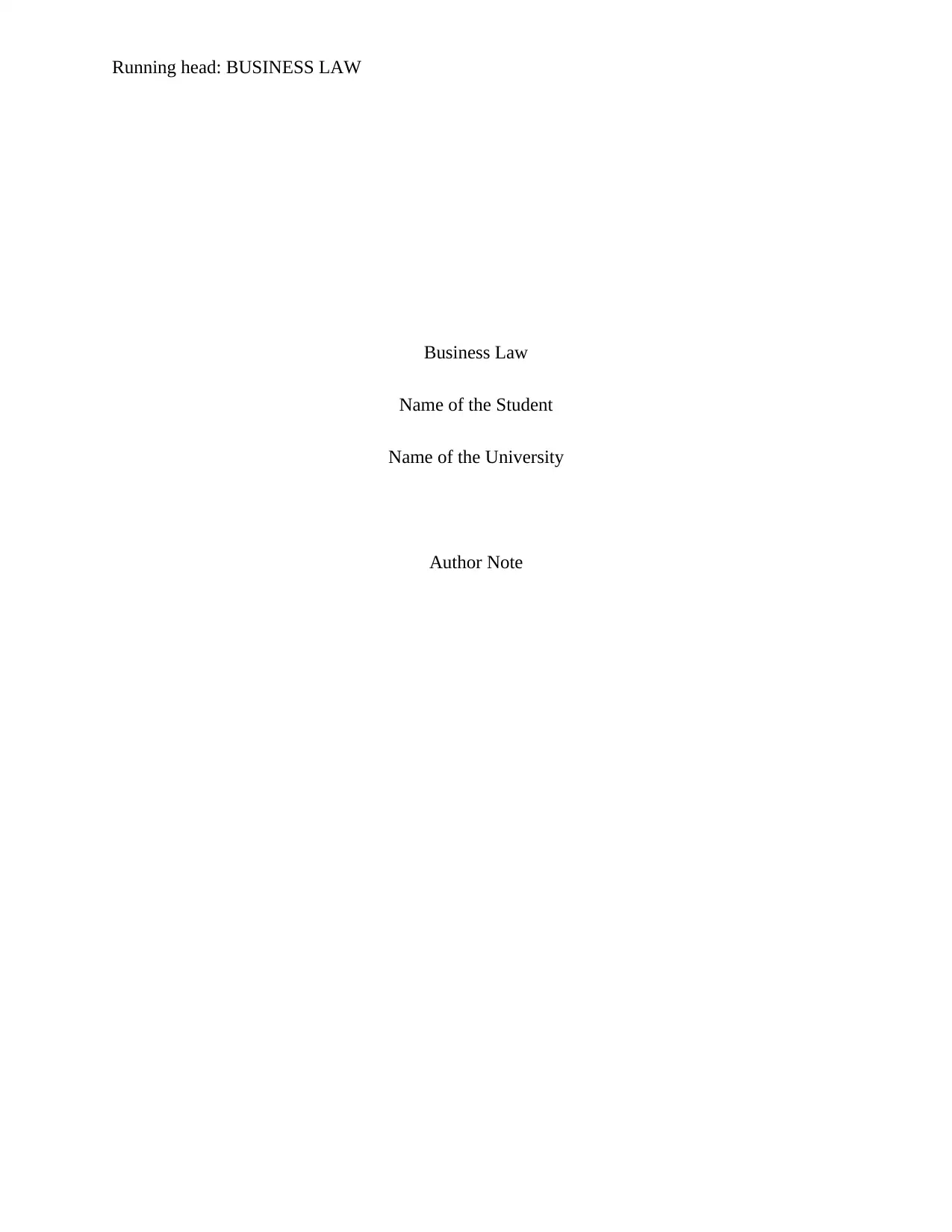
Running head: BUSINESS LAW
Business Law
Name of the Student
Name of the University
Author Note
Business Law
Name of the Student
Name of the University
Author Note
Paraphrase This Document
Need a fresh take? Get an instant paraphrase of this document with our AI Paraphraser
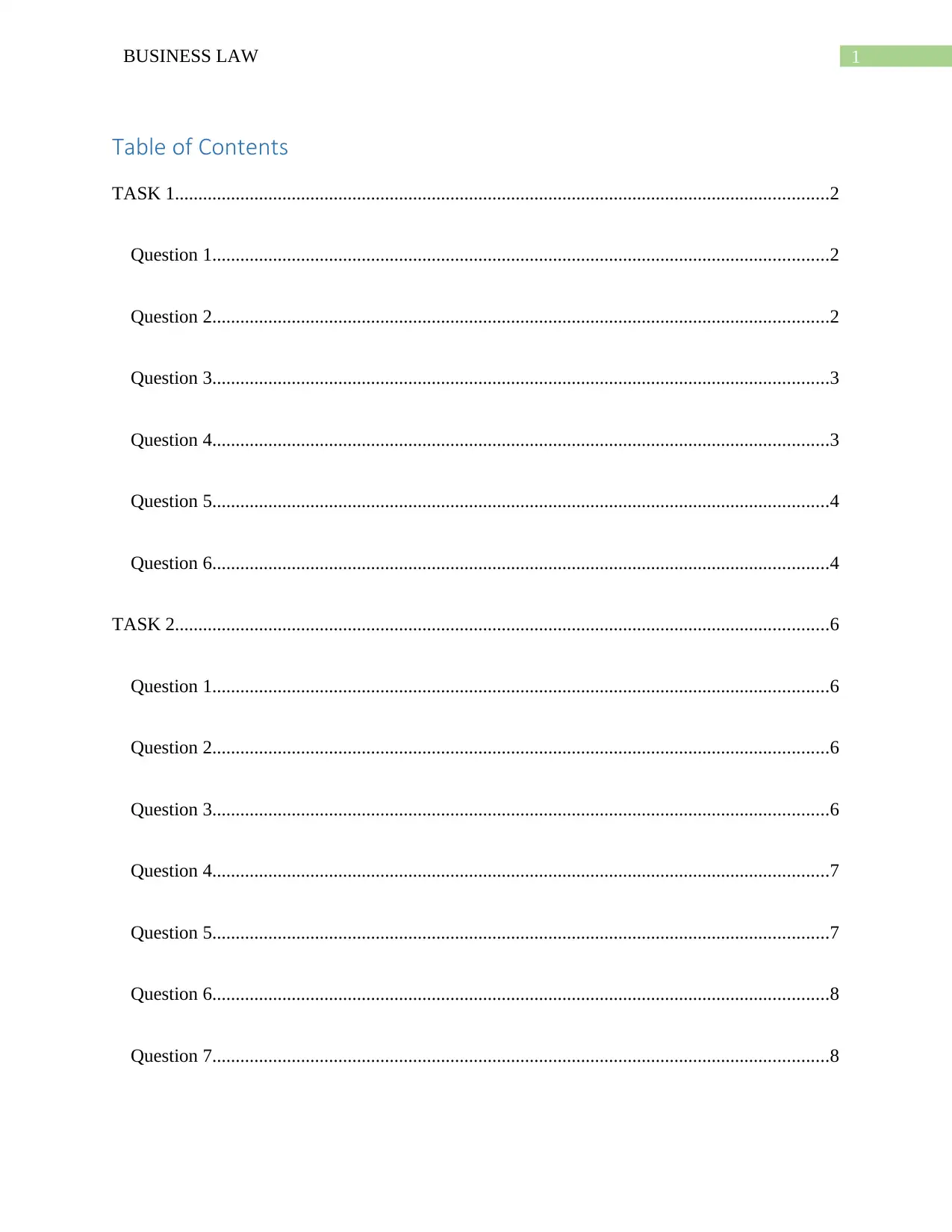
1BUSINESS LAW
Table of Contents
TASK 1............................................................................................................................................2
Question 1....................................................................................................................................2
Question 2....................................................................................................................................2
Question 3....................................................................................................................................3
Question 4....................................................................................................................................3
Question 5....................................................................................................................................4
Question 6....................................................................................................................................4
TASK 2............................................................................................................................................6
Question 1....................................................................................................................................6
Question 2....................................................................................................................................6
Question 3....................................................................................................................................6
Question 4....................................................................................................................................7
Question 5....................................................................................................................................7
Question 6....................................................................................................................................8
Question 7....................................................................................................................................8
Table of Contents
TASK 1............................................................................................................................................2
Question 1....................................................................................................................................2
Question 2....................................................................................................................................2
Question 3....................................................................................................................................3
Question 4....................................................................................................................................3
Question 5....................................................................................................................................4
Question 6....................................................................................................................................4
TASK 2............................................................................................................................................6
Question 1....................................................................................................................................6
Question 2....................................................................................................................................6
Question 3....................................................................................................................................6
Question 4....................................................................................................................................7
Question 5....................................................................................................................................7
Question 6....................................................................................................................................8
Question 7....................................................................................................................................8
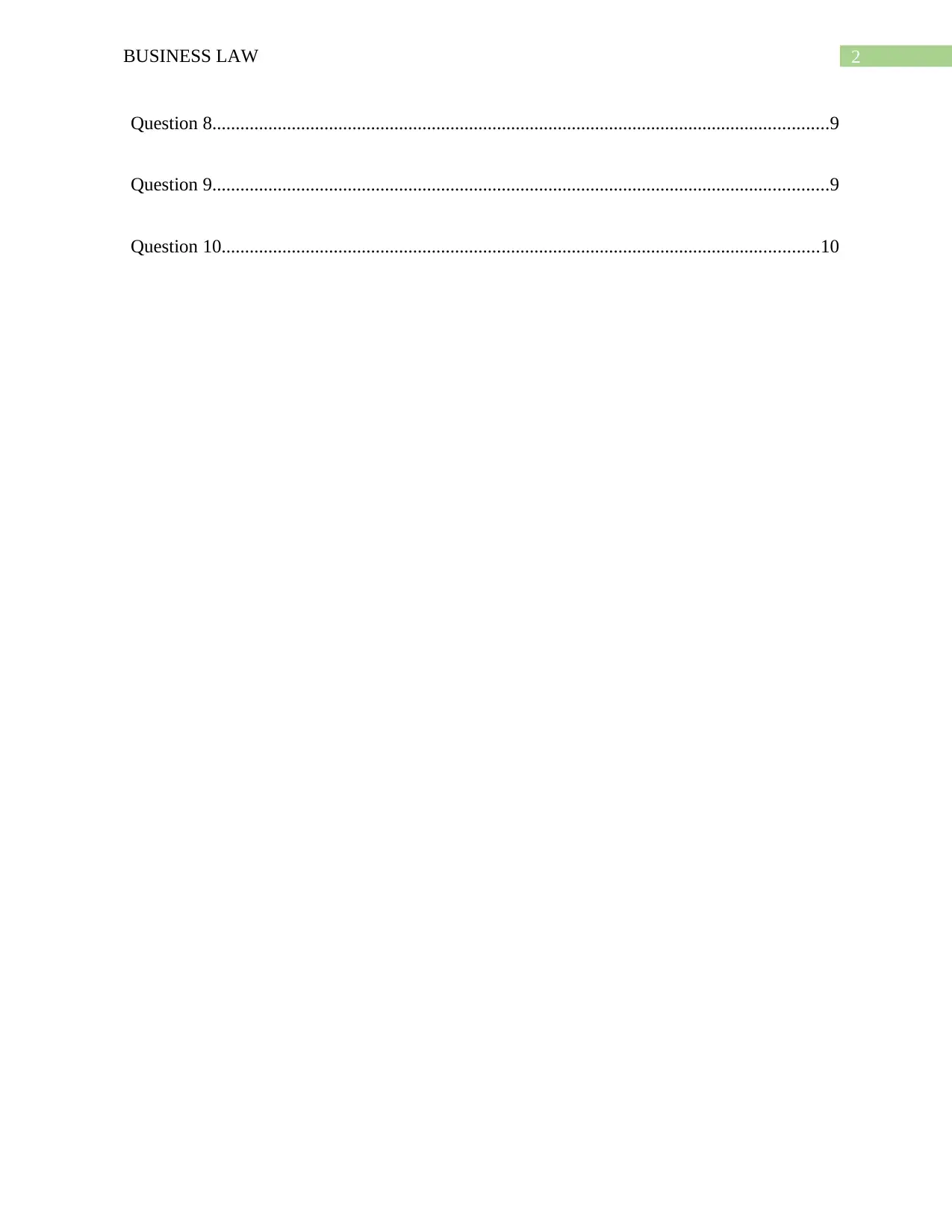
2BUSINESS LAW
Question 8....................................................................................................................................9
Question 9....................................................................................................................................9
Question 10................................................................................................................................10
Question 8....................................................................................................................................9
Question 9....................................................................................................................................9
Question 10................................................................................................................................10
⊘ This is a preview!⊘
Do you want full access?
Subscribe today to unlock all pages.

Trusted by 1+ million students worldwide
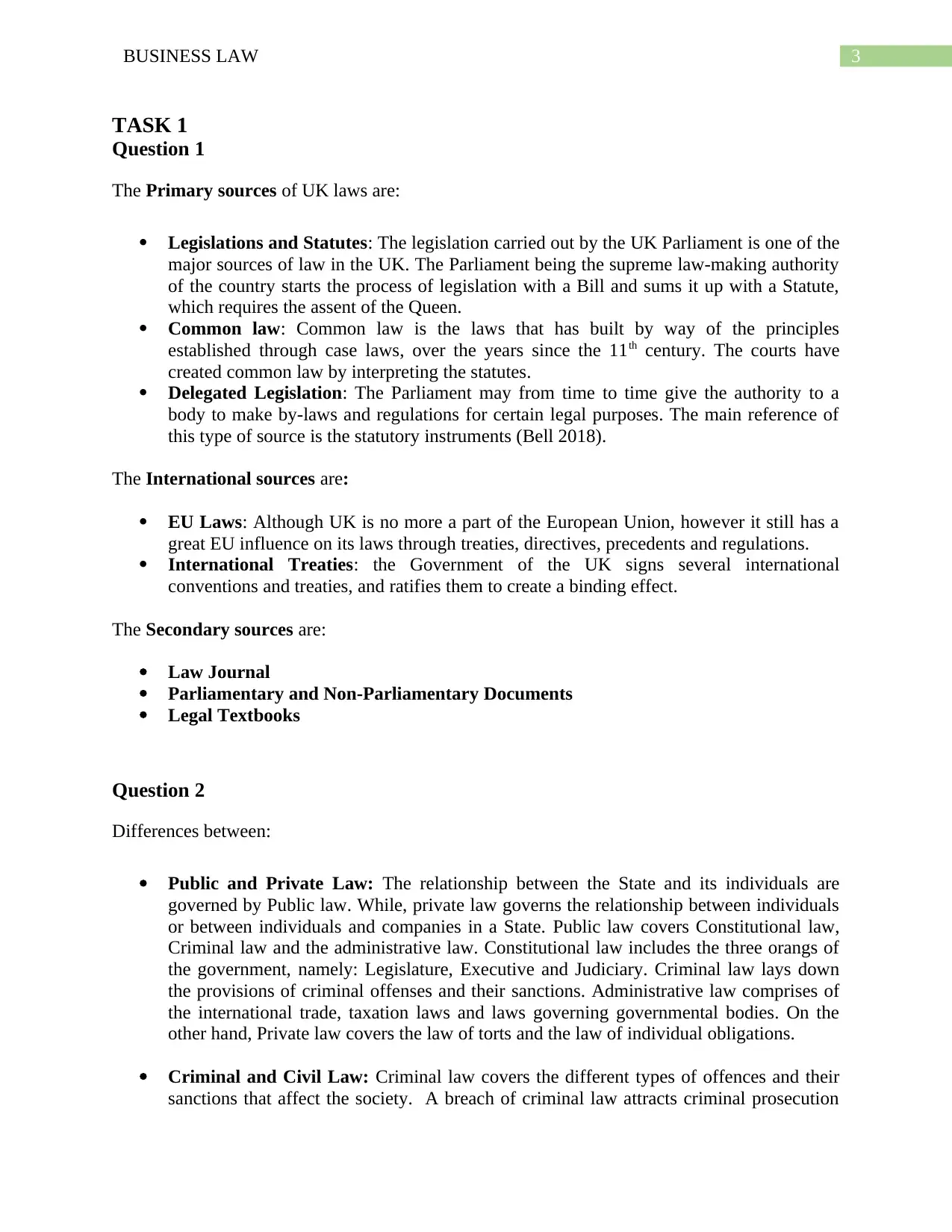
3BUSINESS LAW
TASK 1
Question 1
The Primary sources of UK laws are:
Legislations and Statutes: The legislation carried out by the UK Parliament is one of the
major sources of law in the UK. The Parliament being the supreme law-making authority
of the country starts the process of legislation with a Bill and sums it up with a Statute,
which requires the assent of the Queen.
Common law: Common law is the laws that has built by way of the principles
established through case laws, over the years since the 11th century. The courts have
created common law by interpreting the statutes.
Delegated Legislation: The Parliament may from time to time give the authority to a
body to make by-laws and regulations for certain legal purposes. The main reference of
this type of source is the statutory instruments (Bell 2018).
The International sources are:
EU Laws: Although UK is no more a part of the European Union, however it still has a
great EU influence on its laws through treaties, directives, precedents and regulations.
International Treaties: the Government of the UK signs several international
conventions and treaties, and ratifies them to create a binding effect.
The Secondary sources are:
Law Journal
Parliamentary and Non-Parliamentary Documents
Legal Textbooks
Question 2
Differences between:
Public and Private Law: The relationship between the State and its individuals are
governed by Public law. While, private law governs the relationship between individuals
or between individuals and companies in a State. Public law covers Constitutional law,
Criminal law and the administrative law. Constitutional law includes the three orangs of
the government, namely: Legislature, Executive and Judiciary. Criminal law lays down
the provisions of criminal offenses and their sanctions. Administrative law comprises of
the international trade, taxation laws and laws governing governmental bodies. On the
other hand, Private law covers the law of torts and the law of individual obligations.
Criminal and Civil Law: Criminal law covers the different types of offences and their
sanctions that affect the society. A breach of criminal law attracts criminal prosecution
TASK 1
Question 1
The Primary sources of UK laws are:
Legislations and Statutes: The legislation carried out by the UK Parliament is one of the
major sources of law in the UK. The Parliament being the supreme law-making authority
of the country starts the process of legislation with a Bill and sums it up with a Statute,
which requires the assent of the Queen.
Common law: Common law is the laws that has built by way of the principles
established through case laws, over the years since the 11th century. The courts have
created common law by interpreting the statutes.
Delegated Legislation: The Parliament may from time to time give the authority to a
body to make by-laws and regulations for certain legal purposes. The main reference of
this type of source is the statutory instruments (Bell 2018).
The International sources are:
EU Laws: Although UK is no more a part of the European Union, however it still has a
great EU influence on its laws through treaties, directives, precedents and regulations.
International Treaties: the Government of the UK signs several international
conventions and treaties, and ratifies them to create a binding effect.
The Secondary sources are:
Law Journal
Parliamentary and Non-Parliamentary Documents
Legal Textbooks
Question 2
Differences between:
Public and Private Law: The relationship between the State and its individuals are
governed by Public law. While, private law governs the relationship between individuals
or between individuals and companies in a State. Public law covers Constitutional law,
Criminal law and the administrative law. Constitutional law includes the three orangs of
the government, namely: Legislature, Executive and Judiciary. Criminal law lays down
the provisions of criminal offenses and their sanctions. Administrative law comprises of
the international trade, taxation laws and laws governing governmental bodies. On the
other hand, Private law covers the law of torts and the law of individual obligations.
Criminal and Civil Law: Criminal law covers the different types of offences and their
sanctions that affect the society. A breach of criminal law attracts criminal prosecution
Paraphrase This Document
Need a fresh take? Get an instant paraphrase of this document with our AI Paraphraser
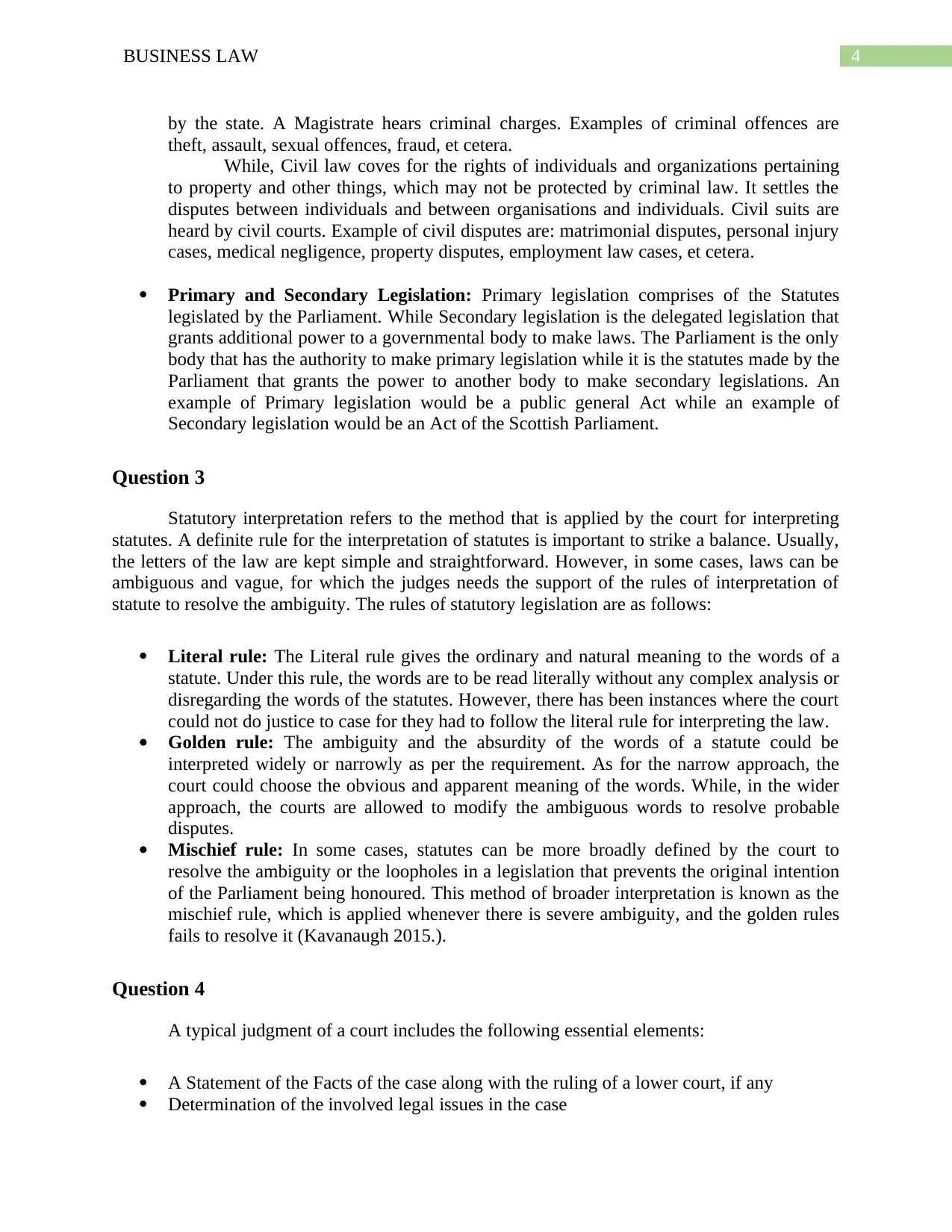
4BUSINESS LAW
by the state. A Magistrate hears criminal charges. Examples of criminal offences are
theft, assault, sexual offences, fraud, et cetera.
While, Civil law coves for the rights of individuals and organizations pertaining
to property and other things, which may not be protected by criminal law. It settles the
disputes between individuals and between organisations and individuals. Civil suits are
heard by civil courts. Example of civil disputes are: matrimonial disputes, personal injury
cases, medical negligence, property disputes, employment law cases, et cetera.
Primary and Secondary Legislation: Primary legislation comprises of the Statutes
legislated by the Parliament. While Secondary legislation is the delegated legislation that
grants additional power to a governmental body to make laws. The Parliament is the only
body that has the authority to make primary legislation while it is the statutes made by the
Parliament that grants the power to another body to make secondary legislations. An
example of Primary legislation would be a public general Act while an example of
Secondary legislation would be an Act of the Scottish Parliament.
Question 3
Statutory interpretation refers to the method that is applied by the court for interpreting
statutes. A definite rule for the interpretation of statutes is important to strike a balance. Usually,
the letters of the law are kept simple and straightforward. However, in some cases, laws can be
ambiguous and vague, for which the judges needs the support of the rules of interpretation of
statute to resolve the ambiguity. The rules of statutory legislation are as follows:
Literal rule: The Literal rule gives the ordinary and natural meaning to the words of a
statute. Under this rule, the words are to be read literally without any complex analysis or
disregarding the words of the statutes. However, there has been instances where the court
could not do justice to case for they had to follow the literal rule for interpreting the law.
Golden rule: The ambiguity and the absurdity of the words of a statute could be
interpreted widely or narrowly as per the requirement. As for the narrow approach, the
court could choose the obvious and apparent meaning of the words. While, in the wider
approach, the courts are allowed to modify the ambiguous words to resolve probable
disputes.
Mischief rule: In some cases, statutes can be more broadly defined by the court to
resolve the ambiguity or the loopholes in a legislation that prevents the original intention
of the Parliament being honoured. This method of broader interpretation is known as the
mischief rule, which is applied whenever there is severe ambiguity, and the golden rules
fails to resolve it (Kavanaugh 2015.).
Question 4
A typical judgment of a court includes the following essential elements:
A Statement of the Facts of the case along with the ruling of a lower court, if any
Determination of the involved legal issues in the case
by the state. A Magistrate hears criminal charges. Examples of criminal offences are
theft, assault, sexual offences, fraud, et cetera.
While, Civil law coves for the rights of individuals and organizations pertaining
to property and other things, which may not be protected by criminal law. It settles the
disputes between individuals and between organisations and individuals. Civil suits are
heard by civil courts. Example of civil disputes are: matrimonial disputes, personal injury
cases, medical negligence, property disputes, employment law cases, et cetera.
Primary and Secondary Legislation: Primary legislation comprises of the Statutes
legislated by the Parliament. While Secondary legislation is the delegated legislation that
grants additional power to a governmental body to make laws. The Parliament is the only
body that has the authority to make primary legislation while it is the statutes made by the
Parliament that grants the power to another body to make secondary legislations. An
example of Primary legislation would be a public general Act while an example of
Secondary legislation would be an Act of the Scottish Parliament.
Question 3
Statutory interpretation refers to the method that is applied by the court for interpreting
statutes. A definite rule for the interpretation of statutes is important to strike a balance. Usually,
the letters of the law are kept simple and straightforward. However, in some cases, laws can be
ambiguous and vague, for which the judges needs the support of the rules of interpretation of
statute to resolve the ambiguity. The rules of statutory legislation are as follows:
Literal rule: The Literal rule gives the ordinary and natural meaning to the words of a
statute. Under this rule, the words are to be read literally without any complex analysis or
disregarding the words of the statutes. However, there has been instances where the court
could not do justice to case for they had to follow the literal rule for interpreting the law.
Golden rule: The ambiguity and the absurdity of the words of a statute could be
interpreted widely or narrowly as per the requirement. As for the narrow approach, the
court could choose the obvious and apparent meaning of the words. While, in the wider
approach, the courts are allowed to modify the ambiguous words to resolve probable
disputes.
Mischief rule: In some cases, statutes can be more broadly defined by the court to
resolve the ambiguity or the loopholes in a legislation that prevents the original intention
of the Parliament being honoured. This method of broader interpretation is known as the
mischief rule, which is applied whenever there is severe ambiguity, and the golden rules
fails to resolve it (Kavanaugh 2015.).
Question 4
A typical judgment of a court includes the following essential elements:
A Statement of the Facts of the case along with the ruling of a lower court, if any
Determination of the involved legal issues in the case
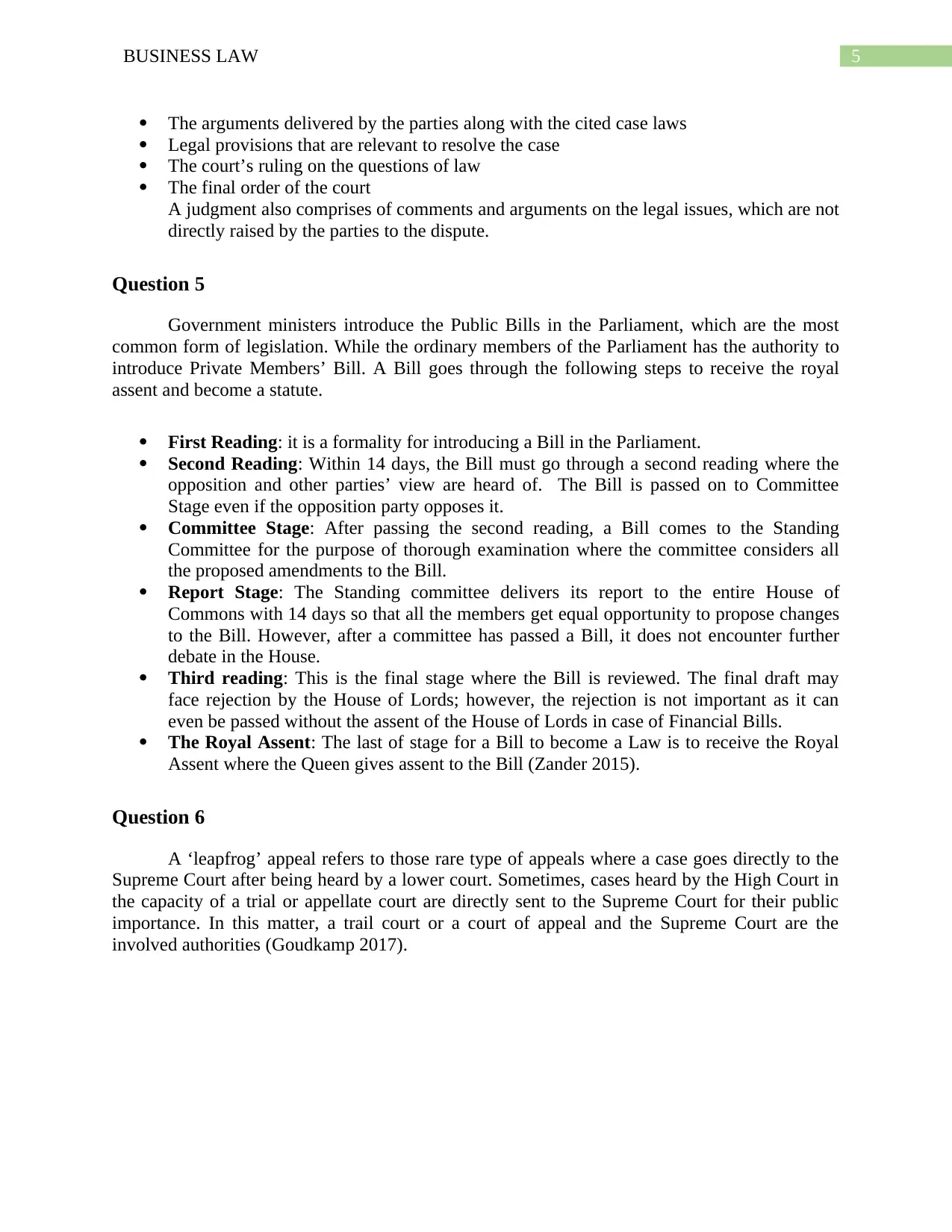
5BUSINESS LAW
The arguments delivered by the parties along with the cited case laws
Legal provisions that are relevant to resolve the case
The court’s ruling on the questions of law
The final order of the court
A judgment also comprises of comments and arguments on the legal issues, which are not
directly raised by the parties to the dispute.
Question 5
Government ministers introduce the Public Bills in the Parliament, which are the most
common form of legislation. While the ordinary members of the Parliament has the authority to
introduce Private Members’ Bill. A Bill goes through the following steps to receive the royal
assent and become a statute.
First Reading: it is a formality for introducing a Bill in the Parliament.
Second Reading: Within 14 days, the Bill must go through a second reading where the
opposition and other parties’ view are heard of. The Bill is passed on to Committee
Stage even if the opposition party opposes it.
Committee Stage: After passing the second reading, a Bill comes to the Standing
Committee for the purpose of thorough examination where the committee considers all
the proposed amendments to the Bill.
Report Stage: The Standing committee delivers its report to the entire House of
Commons with 14 days so that all the members get equal opportunity to propose changes
to the Bill. However, after a committee has passed a Bill, it does not encounter further
debate in the House.
Third reading: This is the final stage where the Bill is reviewed. The final draft may
face rejection by the House of Lords; however, the rejection is not important as it can
even be passed without the assent of the House of Lords in case of Financial Bills.
The Royal Assent: The last of stage for a Bill to become a Law is to receive the Royal
Assent where the Queen gives assent to the Bill (Zander 2015).
Question 6
A ‘leapfrog’ appeal refers to those rare type of appeals where a case goes directly to the
Supreme Court after being heard by a lower court. Sometimes, cases heard by the High Court in
the capacity of a trial or appellate court are directly sent to the Supreme Court for their public
importance. In this matter, a trail court or a court of appeal and the Supreme Court are the
involved authorities (Goudkamp 2017).
The arguments delivered by the parties along with the cited case laws
Legal provisions that are relevant to resolve the case
The court’s ruling on the questions of law
The final order of the court
A judgment also comprises of comments and arguments on the legal issues, which are not
directly raised by the parties to the dispute.
Question 5
Government ministers introduce the Public Bills in the Parliament, which are the most
common form of legislation. While the ordinary members of the Parliament has the authority to
introduce Private Members’ Bill. A Bill goes through the following steps to receive the royal
assent and become a statute.
First Reading: it is a formality for introducing a Bill in the Parliament.
Second Reading: Within 14 days, the Bill must go through a second reading where the
opposition and other parties’ view are heard of. The Bill is passed on to Committee
Stage even if the opposition party opposes it.
Committee Stage: After passing the second reading, a Bill comes to the Standing
Committee for the purpose of thorough examination where the committee considers all
the proposed amendments to the Bill.
Report Stage: The Standing committee delivers its report to the entire House of
Commons with 14 days so that all the members get equal opportunity to propose changes
to the Bill. However, after a committee has passed a Bill, it does not encounter further
debate in the House.
Third reading: This is the final stage where the Bill is reviewed. The final draft may
face rejection by the House of Lords; however, the rejection is not important as it can
even be passed without the assent of the House of Lords in case of Financial Bills.
The Royal Assent: The last of stage for a Bill to become a Law is to receive the Royal
Assent where the Queen gives assent to the Bill (Zander 2015).
Question 6
A ‘leapfrog’ appeal refers to those rare type of appeals where a case goes directly to the
Supreme Court after being heard by a lower court. Sometimes, cases heard by the High Court in
the capacity of a trial or appellate court are directly sent to the Supreme Court for their public
importance. In this matter, a trail court or a court of appeal and the Supreme Court are the
involved authorities (Goudkamp 2017).
⊘ This is a preview!⊘
Do you want full access?
Subscribe today to unlock all pages.

Trusted by 1+ million students worldwide
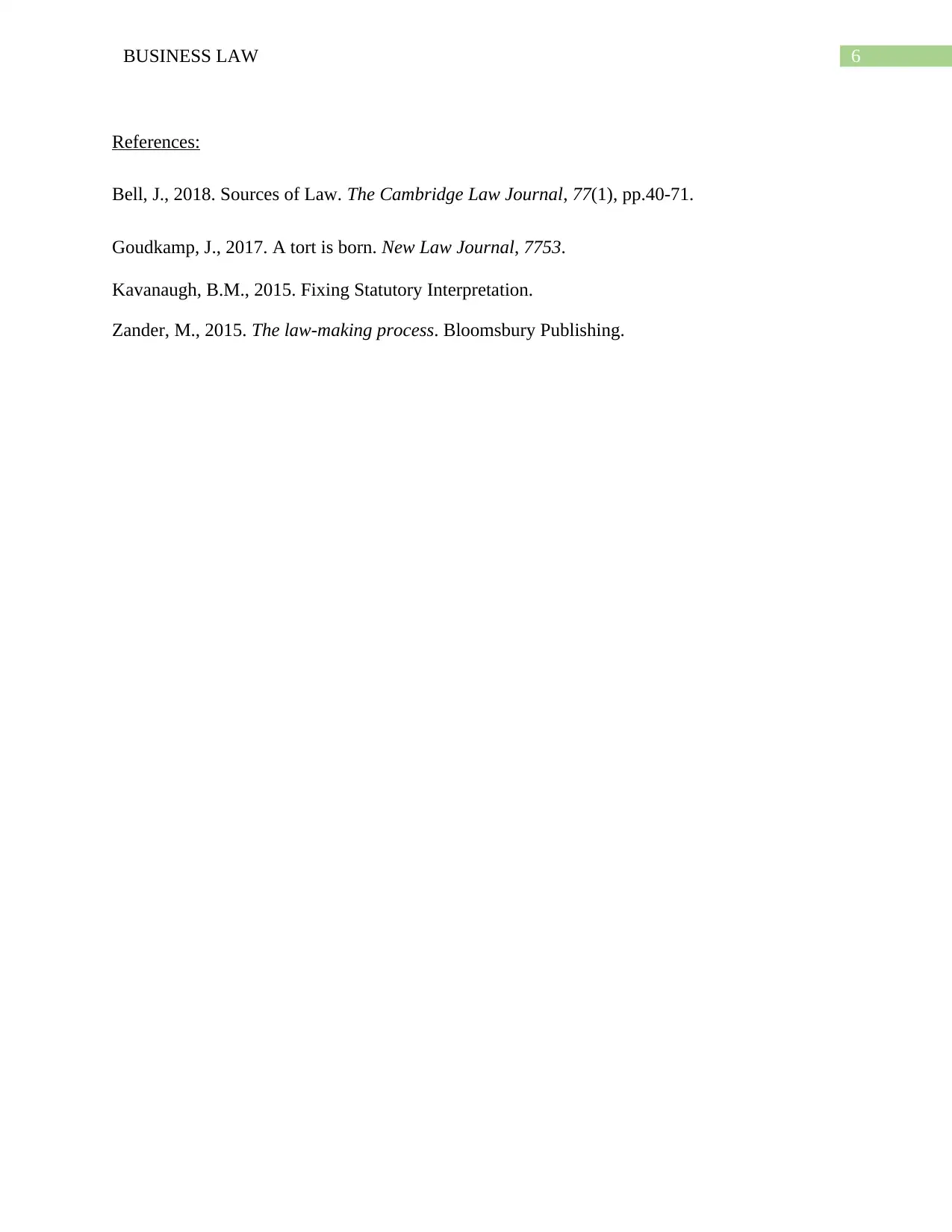
6BUSINESS LAW
References:
Bell, J., 2018. Sources of Law. The Cambridge Law Journal, 77(1), pp.40-71.
Goudkamp, J., 2017. A tort is born. New Law Journal, 7753.
Kavanaugh, B.M., 2015. Fixing Statutory Interpretation.
Zander, M., 2015. The law-making process. Bloomsbury Publishing.
References:
Bell, J., 2018. Sources of Law. The Cambridge Law Journal, 77(1), pp.40-71.
Goudkamp, J., 2017. A tort is born. New Law Journal, 7753.
Kavanaugh, B.M., 2015. Fixing Statutory Interpretation.
Zander, M., 2015. The law-making process. Bloomsbury Publishing.
Paraphrase This Document
Need a fresh take? Get an instant paraphrase of this document with our AI Paraphraser
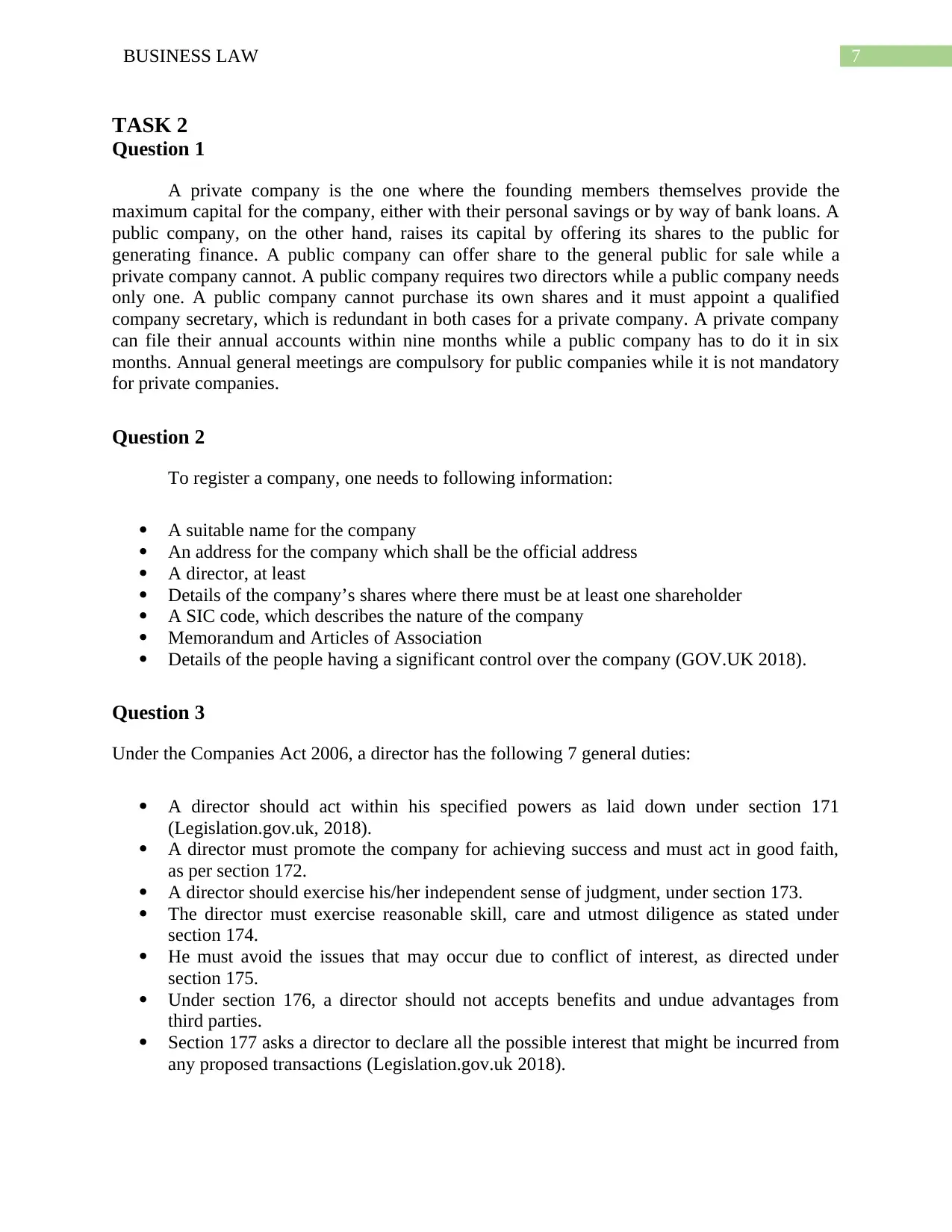
7BUSINESS LAW
TASK 2
Question 1
A private company is the one where the founding members themselves provide the
maximum capital for the company, either with their personal savings or by way of bank loans. A
public company, on the other hand, raises its capital by offering its shares to the public for
generating finance. A public company can offer share to the general public for sale while a
private company cannot. A public company requires two directors while a public company needs
only one. A public company cannot purchase its own shares and it must appoint a qualified
company secretary, which is redundant in both cases for a private company. A private company
can file their annual accounts within nine months while a public company has to do it in six
months. Annual general meetings are compulsory for public companies while it is not mandatory
for private companies.
Question 2
To register a company, one needs to following information:
A suitable name for the company
An address for the company which shall be the official address
A director, at least
Details of the company’s shares where there must be at least one shareholder
A SIC code, which describes the nature of the company
Memorandum and Articles of Association
Details of the people having a significant control over the company (GOV.UK 2018).
Question 3
Under the Companies Act 2006, a director has the following 7 general duties:
A director should act within his specified powers as laid down under section 171
(Legislation.gov.uk, 2018).
A director must promote the company for achieving success and must act in good faith,
as per section 172.
A director should exercise his/her independent sense of judgment, under section 173.
The director must exercise reasonable skill, care and utmost diligence as stated under
section 174.
He must avoid the issues that may occur due to conflict of interest, as directed under
section 175.
Under section 176, a director should not accepts benefits and undue advantages from
third parties.
Section 177 asks a director to declare all the possible interest that might be incurred from
any proposed transactions (Legislation.gov.uk 2018).
TASK 2
Question 1
A private company is the one where the founding members themselves provide the
maximum capital for the company, either with their personal savings or by way of bank loans. A
public company, on the other hand, raises its capital by offering its shares to the public for
generating finance. A public company can offer share to the general public for sale while a
private company cannot. A public company requires two directors while a public company needs
only one. A public company cannot purchase its own shares and it must appoint a qualified
company secretary, which is redundant in both cases for a private company. A private company
can file their annual accounts within nine months while a public company has to do it in six
months. Annual general meetings are compulsory for public companies while it is not mandatory
for private companies.
Question 2
To register a company, one needs to following information:
A suitable name for the company
An address for the company which shall be the official address
A director, at least
Details of the company’s shares where there must be at least one shareholder
A SIC code, which describes the nature of the company
Memorandum and Articles of Association
Details of the people having a significant control over the company (GOV.UK 2018).
Question 3
Under the Companies Act 2006, a director has the following 7 general duties:
A director should act within his specified powers as laid down under section 171
(Legislation.gov.uk, 2018).
A director must promote the company for achieving success and must act in good faith,
as per section 172.
A director should exercise his/her independent sense of judgment, under section 173.
The director must exercise reasonable skill, care and utmost diligence as stated under
section 174.
He must avoid the issues that may occur due to conflict of interest, as directed under
section 175.
Under section 176, a director should not accepts benefits and undue advantages from
third parties.
Section 177 asks a director to declare all the possible interest that might be incurred from
any proposed transactions (Legislation.gov.uk 2018).
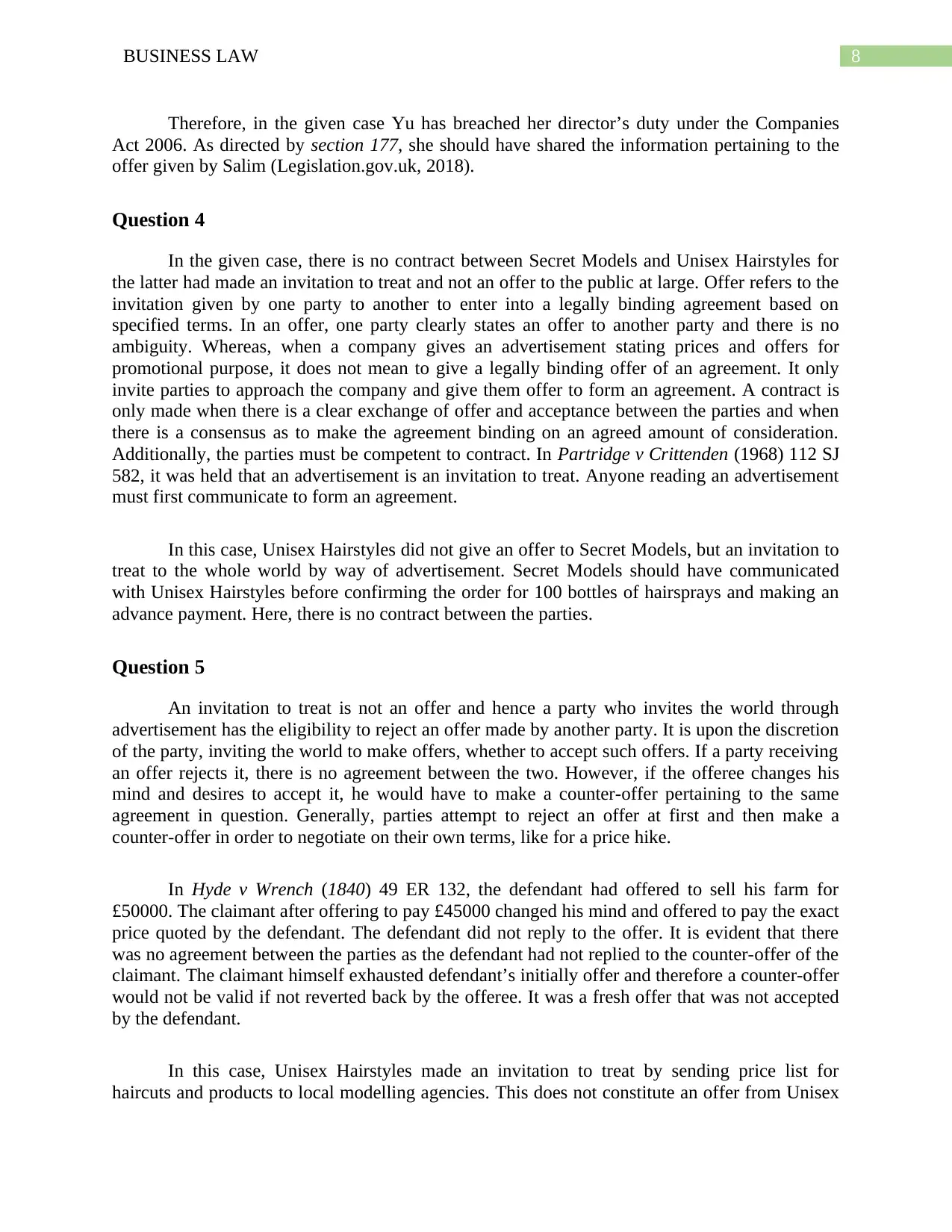
8BUSINESS LAW
Therefore, in the given case Yu has breached her director’s duty under the Companies
Act 2006. As directed by section 177, she should have shared the information pertaining to the
offer given by Salim (Legislation.gov.uk, 2018).
Question 4
In the given case, there is no contract between Secret Models and Unisex Hairstyles for
the latter had made an invitation to treat and not an offer to the public at large. Offer refers to the
invitation given by one party to another to enter into a legally binding agreement based on
specified terms. In an offer, one party clearly states an offer to another party and there is no
ambiguity. Whereas, when a company gives an advertisement stating prices and offers for
promotional purpose, it does not mean to give a legally binding offer of an agreement. It only
invite parties to approach the company and give them offer to form an agreement. A contract is
only made when there is a clear exchange of offer and acceptance between the parties and when
there is a consensus as to make the agreement binding on an agreed amount of consideration.
Additionally, the parties must be competent to contract. In Partridge v Crittenden (1968) 112 SJ
582, it was held that an advertisement is an invitation to treat. Anyone reading an advertisement
must first communicate to form an agreement.
In this case, Unisex Hairstyles did not give an offer to Secret Models, but an invitation to
treat to the whole world by way of advertisement. Secret Models should have communicated
with Unisex Hairstyles before confirming the order for 100 bottles of hairsprays and making an
advance payment. Here, there is no contract between the parties.
Question 5
An invitation to treat is not an offer and hence a party who invites the world through
advertisement has the eligibility to reject an offer made by another party. It is upon the discretion
of the party, inviting the world to make offers, whether to accept such offers. If a party receiving
an offer rejects it, there is no agreement between the two. However, if the offeree changes his
mind and desires to accept it, he would have to make a counter-offer pertaining to the same
agreement in question. Generally, parties attempt to reject an offer at first and then make a
counter-offer in order to negotiate on their own terms, like for a price hike.
In Hyde v Wrench (1840) 49 ER 132, the defendant had offered to sell his farm for
£50000. The claimant after offering to pay £45000 changed his mind and offered to pay the exact
price quoted by the defendant. The defendant did not reply to the offer. It is evident that there
was no agreement between the parties as the defendant had not replied to the counter-offer of the
claimant. The claimant himself exhausted defendant’s initially offer and therefore a counter-offer
would not be valid if not reverted back by the offeree. It was a fresh offer that was not accepted
by the defendant.
In this case, Unisex Hairstyles made an invitation to treat by sending price list for
haircuts and products to local modelling agencies. This does not constitute an offer from Unisex
Therefore, in the given case Yu has breached her director’s duty under the Companies
Act 2006. As directed by section 177, she should have shared the information pertaining to the
offer given by Salim (Legislation.gov.uk, 2018).
Question 4
In the given case, there is no contract between Secret Models and Unisex Hairstyles for
the latter had made an invitation to treat and not an offer to the public at large. Offer refers to the
invitation given by one party to another to enter into a legally binding agreement based on
specified terms. In an offer, one party clearly states an offer to another party and there is no
ambiguity. Whereas, when a company gives an advertisement stating prices and offers for
promotional purpose, it does not mean to give a legally binding offer of an agreement. It only
invite parties to approach the company and give them offer to form an agreement. A contract is
only made when there is a clear exchange of offer and acceptance between the parties and when
there is a consensus as to make the agreement binding on an agreed amount of consideration.
Additionally, the parties must be competent to contract. In Partridge v Crittenden (1968) 112 SJ
582, it was held that an advertisement is an invitation to treat. Anyone reading an advertisement
must first communicate to form an agreement.
In this case, Unisex Hairstyles did not give an offer to Secret Models, but an invitation to
treat to the whole world by way of advertisement. Secret Models should have communicated
with Unisex Hairstyles before confirming the order for 100 bottles of hairsprays and making an
advance payment. Here, there is no contract between the parties.
Question 5
An invitation to treat is not an offer and hence a party who invites the world through
advertisement has the eligibility to reject an offer made by another party. It is upon the discretion
of the party, inviting the world to make offers, whether to accept such offers. If a party receiving
an offer rejects it, there is no agreement between the two. However, if the offeree changes his
mind and desires to accept it, he would have to make a counter-offer pertaining to the same
agreement in question. Generally, parties attempt to reject an offer at first and then make a
counter-offer in order to negotiate on their own terms, like for a price hike.
In Hyde v Wrench (1840) 49 ER 132, the defendant had offered to sell his farm for
£50000. The claimant after offering to pay £45000 changed his mind and offered to pay the exact
price quoted by the defendant. The defendant did not reply to the offer. It is evident that there
was no agreement between the parties as the defendant had not replied to the counter-offer of the
claimant. The claimant himself exhausted defendant’s initially offer and therefore a counter-offer
would not be valid if not reverted back by the offeree. It was a fresh offer that was not accepted
by the defendant.
In this case, Unisex Hairstyles made an invitation to treat by sending price list for
haircuts and products to local modelling agencies. This does not constitute an offer from Unisex
⊘ This is a preview!⊘
Do you want full access?
Subscribe today to unlock all pages.

Trusted by 1+ million students worldwide
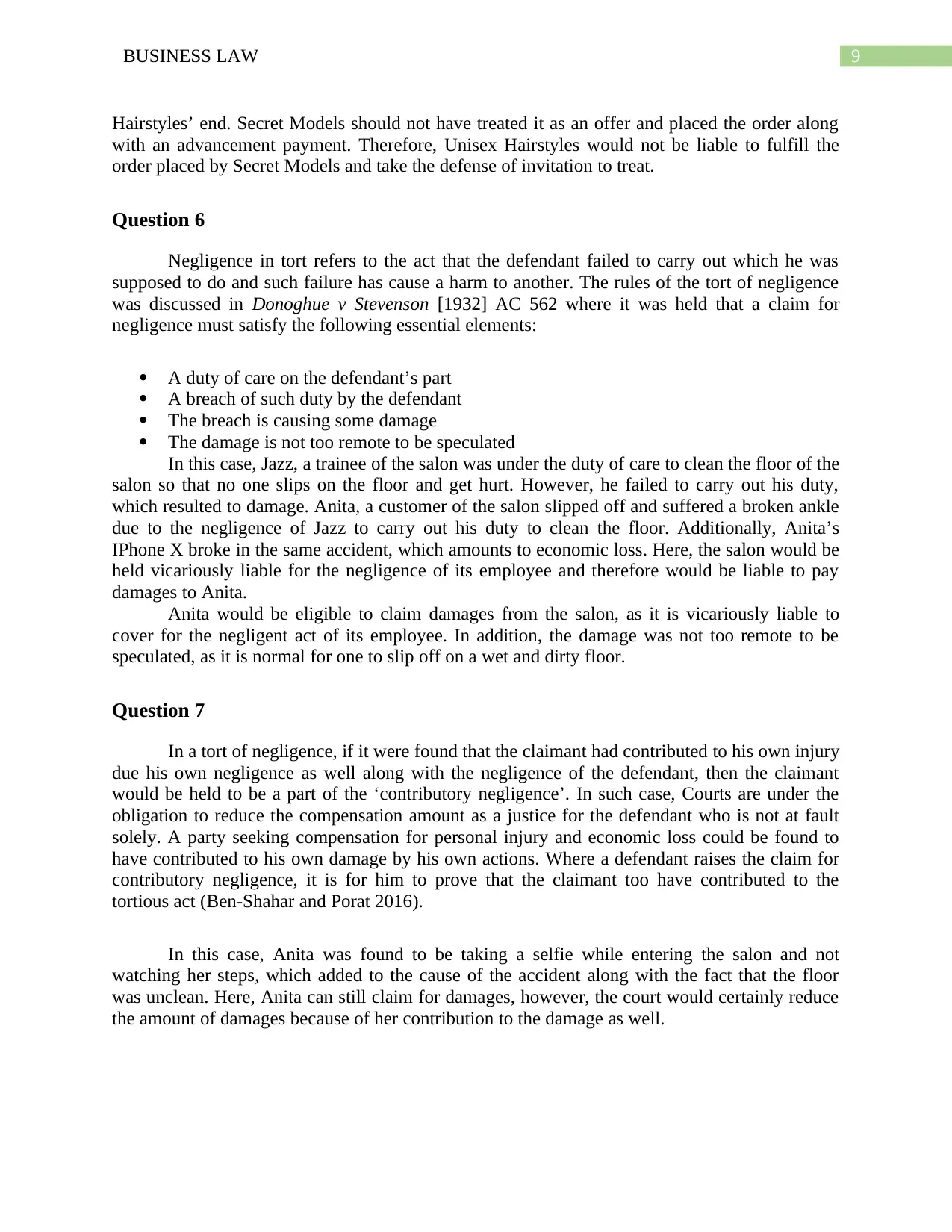
9BUSINESS LAW
Hairstyles’ end. Secret Models should not have treated it as an offer and placed the order along
with an advancement payment. Therefore, Unisex Hairstyles would not be liable to fulfill the
order placed by Secret Models and take the defense of invitation to treat.
Question 6
Negligence in tort refers to the act that the defendant failed to carry out which he was
supposed to do and such failure has cause a harm to another. The rules of the tort of negligence
was discussed in Donoghue v Stevenson [1932] AC 562 where it was held that a claim for
negligence must satisfy the following essential elements:
A duty of care on the defendant’s part
A breach of such duty by the defendant
The breach is causing some damage
The damage is not too remote to be speculated
In this case, Jazz, a trainee of the salon was under the duty of care to clean the floor of the
salon so that no one slips on the floor and get hurt. However, he failed to carry out his duty,
which resulted to damage. Anita, a customer of the salon slipped off and suffered a broken ankle
due to the negligence of Jazz to carry out his duty to clean the floor. Additionally, Anita’s
IPhone X broke in the same accident, which amounts to economic loss. Here, the salon would be
held vicariously liable for the negligence of its employee and therefore would be liable to pay
damages to Anita.
Anita would be eligible to claim damages from the salon, as it is vicariously liable to
cover for the negligent act of its employee. In addition, the damage was not too remote to be
speculated, as it is normal for one to slip off on a wet and dirty floor.
Question 7
In a tort of negligence, if it were found that the claimant had contributed to his own injury
due his own negligence as well along with the negligence of the defendant, then the claimant
would be held to be a part of the ‘contributory negligence’. In such case, Courts are under the
obligation to reduce the compensation amount as a justice for the defendant who is not at fault
solely. A party seeking compensation for personal injury and economic loss could be found to
have contributed to his own damage by his own actions. Where a defendant raises the claim for
contributory negligence, it is for him to prove that the claimant too have contributed to the
tortious act (Ben-Shahar and Porat 2016).
In this case, Anita was found to be taking a selfie while entering the salon and not
watching her steps, which added to the cause of the accident along with the fact that the floor
was unclean. Here, Anita can still claim for damages, however, the court would certainly reduce
the amount of damages because of her contribution to the damage as well.
Hairstyles’ end. Secret Models should not have treated it as an offer and placed the order along
with an advancement payment. Therefore, Unisex Hairstyles would not be liable to fulfill the
order placed by Secret Models and take the defense of invitation to treat.
Question 6
Negligence in tort refers to the act that the defendant failed to carry out which he was
supposed to do and such failure has cause a harm to another. The rules of the tort of negligence
was discussed in Donoghue v Stevenson [1932] AC 562 where it was held that a claim for
negligence must satisfy the following essential elements:
A duty of care on the defendant’s part
A breach of such duty by the defendant
The breach is causing some damage
The damage is not too remote to be speculated
In this case, Jazz, a trainee of the salon was under the duty of care to clean the floor of the
salon so that no one slips on the floor and get hurt. However, he failed to carry out his duty,
which resulted to damage. Anita, a customer of the salon slipped off and suffered a broken ankle
due to the negligence of Jazz to carry out his duty to clean the floor. Additionally, Anita’s
IPhone X broke in the same accident, which amounts to economic loss. Here, the salon would be
held vicariously liable for the negligence of its employee and therefore would be liable to pay
damages to Anita.
Anita would be eligible to claim damages from the salon, as it is vicariously liable to
cover for the negligent act of its employee. In addition, the damage was not too remote to be
speculated, as it is normal for one to slip off on a wet and dirty floor.
Question 7
In a tort of negligence, if it were found that the claimant had contributed to his own injury
due his own negligence as well along with the negligence of the defendant, then the claimant
would be held to be a part of the ‘contributory negligence’. In such case, Courts are under the
obligation to reduce the compensation amount as a justice for the defendant who is not at fault
solely. A party seeking compensation for personal injury and economic loss could be found to
have contributed to his own damage by his own actions. Where a defendant raises the claim for
contributory negligence, it is for him to prove that the claimant too have contributed to the
tortious act (Ben-Shahar and Porat 2016).
In this case, Anita was found to be taking a selfie while entering the salon and not
watching her steps, which added to the cause of the accident along with the fact that the floor
was unclean. Here, Anita can still claim for damages, however, the court would certainly reduce
the amount of damages because of her contribution to the damage as well.
Paraphrase This Document
Need a fresh take? Get an instant paraphrase of this document with our AI Paraphraser
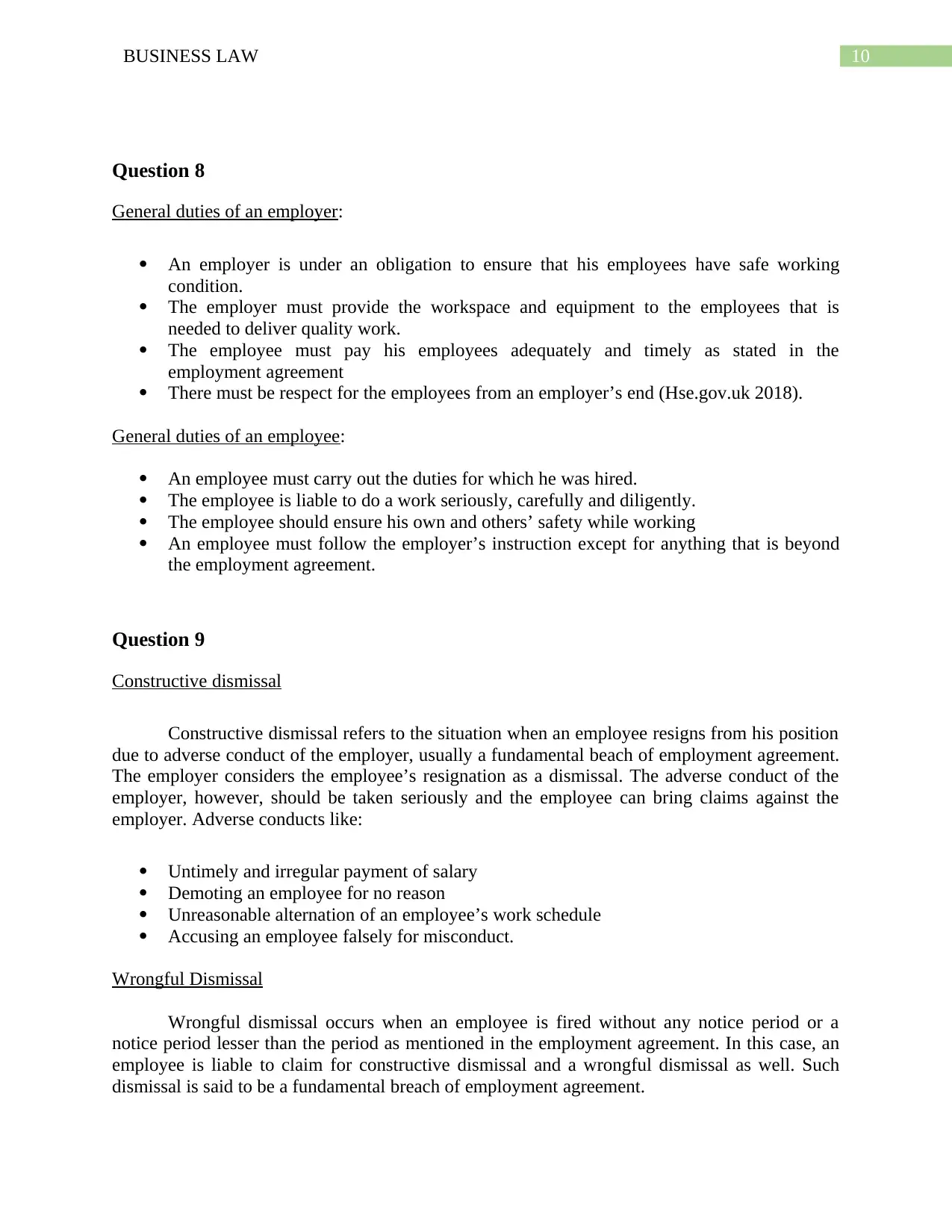
10BUSINESS LAW
Question 8
General duties of an employer:
An employer is under an obligation to ensure that his employees have safe working
condition.
The employer must provide the workspace and equipment to the employees that is
needed to deliver quality work.
The employee must pay his employees adequately and timely as stated in the
employment agreement
There must be respect for the employees from an employer’s end (Hse.gov.uk 2018).
General duties of an employee:
An employee must carry out the duties for which he was hired.
The employee is liable to do a work seriously, carefully and diligently.
The employee should ensure his own and others’ safety while working
An employee must follow the employer’s instruction except for anything that is beyond
the employment agreement.
Question 9
Constructive dismissal
Constructive dismissal refers to the situation when an employee resigns from his position
due to adverse conduct of the employer, usually a fundamental beach of employment agreement.
The employer considers the employee’s resignation as a dismissal. The adverse conduct of the
employer, however, should be taken seriously and the employee can bring claims against the
employer. Adverse conducts like:
Untimely and irregular payment of salary
Demoting an employee for no reason
Unreasonable alternation of an employee’s work schedule
Accusing an employee falsely for misconduct.
Wrongful Dismissal
Wrongful dismissal occurs when an employee is fired without any notice period or a
notice period lesser than the period as mentioned in the employment agreement. In this case, an
employee is liable to claim for constructive dismissal and a wrongful dismissal as well. Such
dismissal is said to be a fundamental breach of employment agreement.
Question 8
General duties of an employer:
An employer is under an obligation to ensure that his employees have safe working
condition.
The employer must provide the workspace and equipment to the employees that is
needed to deliver quality work.
The employee must pay his employees adequately and timely as stated in the
employment agreement
There must be respect for the employees from an employer’s end (Hse.gov.uk 2018).
General duties of an employee:
An employee must carry out the duties for which he was hired.
The employee is liable to do a work seriously, carefully and diligently.
The employee should ensure his own and others’ safety while working
An employee must follow the employer’s instruction except for anything that is beyond
the employment agreement.
Question 9
Constructive dismissal
Constructive dismissal refers to the situation when an employee resigns from his position
due to adverse conduct of the employer, usually a fundamental beach of employment agreement.
The employer considers the employee’s resignation as a dismissal. The adverse conduct of the
employer, however, should be taken seriously and the employee can bring claims against the
employer. Adverse conducts like:
Untimely and irregular payment of salary
Demoting an employee for no reason
Unreasonable alternation of an employee’s work schedule
Accusing an employee falsely for misconduct.
Wrongful Dismissal
Wrongful dismissal occurs when an employee is fired without any notice period or a
notice period lesser than the period as mentioned in the employment agreement. In this case, an
employee is liable to claim for constructive dismissal and a wrongful dismissal as well. Such
dismissal is said to be a fundamental breach of employment agreement.
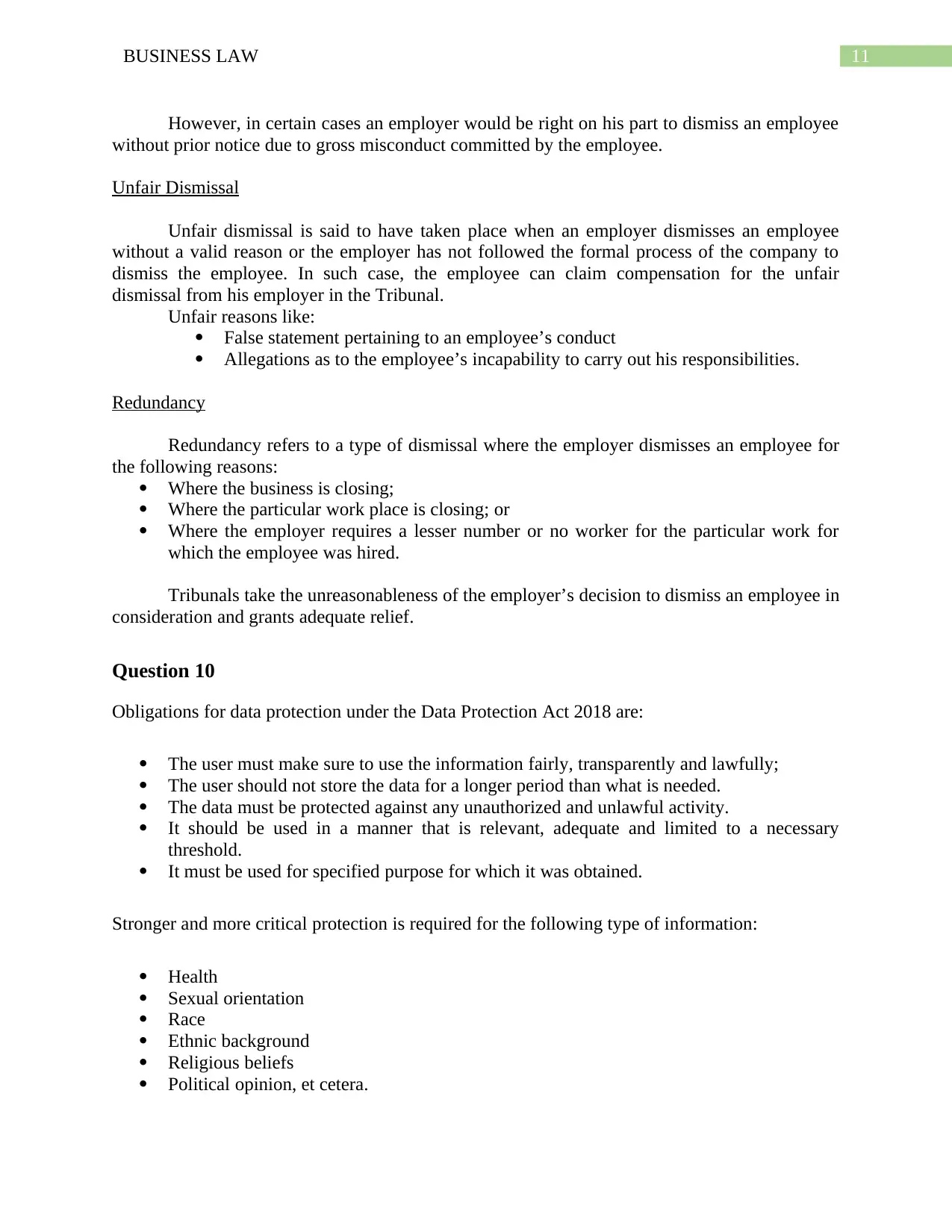
11BUSINESS LAW
However, in certain cases an employer would be right on his part to dismiss an employee
without prior notice due to gross misconduct committed by the employee.
Unfair Dismissal
Unfair dismissal is said to have taken place when an employer dismisses an employee
without a valid reason or the employer has not followed the formal process of the company to
dismiss the employee. In such case, the employee can claim compensation for the unfair
dismissal from his employer in the Tribunal.
Unfair reasons like:
False statement pertaining to an employee’s conduct
Allegations as to the employee’s incapability to carry out his responsibilities.
Redundancy
Redundancy refers to a type of dismissal where the employer dismisses an employee for
the following reasons:
Where the business is closing;
Where the particular work place is closing; or
Where the employer requires a lesser number or no worker for the particular work for
which the employee was hired.
Tribunals take the unreasonableness of the employer’s decision to dismiss an employee in
consideration and grants adequate relief.
Question 10
Obligations for data protection under the Data Protection Act 2018 are:
The user must make sure to use the information fairly, transparently and lawfully;
The user should not store the data for a longer period than what is needed.
The data must be protected against any unauthorized and unlawful activity.
It should be used in a manner that is relevant, adequate and limited to a necessary
threshold.
It must be used for specified purpose for which it was obtained.
Stronger and more critical protection is required for the following type of information:
Health
Sexual orientation
Race
Ethnic background
Religious beliefs
Political opinion, et cetera.
However, in certain cases an employer would be right on his part to dismiss an employee
without prior notice due to gross misconduct committed by the employee.
Unfair Dismissal
Unfair dismissal is said to have taken place when an employer dismisses an employee
without a valid reason or the employer has not followed the formal process of the company to
dismiss the employee. In such case, the employee can claim compensation for the unfair
dismissal from his employer in the Tribunal.
Unfair reasons like:
False statement pertaining to an employee’s conduct
Allegations as to the employee’s incapability to carry out his responsibilities.
Redundancy
Redundancy refers to a type of dismissal where the employer dismisses an employee for
the following reasons:
Where the business is closing;
Where the particular work place is closing; or
Where the employer requires a lesser number or no worker for the particular work for
which the employee was hired.
Tribunals take the unreasonableness of the employer’s decision to dismiss an employee in
consideration and grants adequate relief.
Question 10
Obligations for data protection under the Data Protection Act 2018 are:
The user must make sure to use the information fairly, transparently and lawfully;
The user should not store the data for a longer period than what is needed.
The data must be protected against any unauthorized and unlawful activity.
It should be used in a manner that is relevant, adequate and limited to a necessary
threshold.
It must be used for specified purpose for which it was obtained.
Stronger and more critical protection is required for the following type of information:
Health
Sexual orientation
Race
Ethnic background
Religious beliefs
Political opinion, et cetera.
⊘ This is a preview!⊘
Do you want full access?
Subscribe today to unlock all pages.

Trusted by 1+ million students worldwide
1 out of 13
Related Documents
Your All-in-One AI-Powered Toolkit for Academic Success.
+13062052269
info@desklib.com
Available 24*7 on WhatsApp / Email
![[object Object]](/_next/static/media/star-bottom.7253800d.svg)
Unlock your academic potential
Copyright © 2020–2025 A2Z Services. All Rights Reserved. Developed and managed by ZUCOL.




